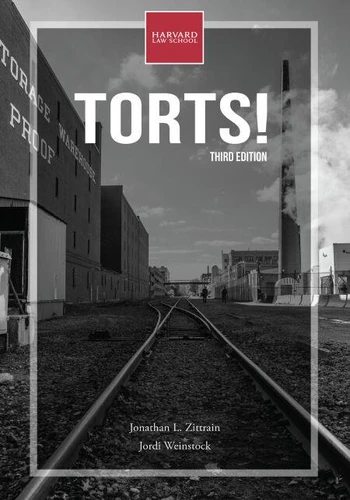Torts!, third edition
Par : ,Formats :
Disponible dans votre compte client Decitre ou Furet du Nord dès validation de votre commande. Le format ePub protégé est :
- Compatible avec une lecture sur My Vivlio (smartphone, tablette, ordinateur)
- Compatible avec une lecture sur liseuses Vivlio
- Pour les liseuses autres que Vivlio, vous devez utiliser le logiciel Adobe Digital Edition. Non compatible avec la lecture sur les liseuses Kindle, Remarkable et Sony
- Non compatible avec un achat hors France métropolitaine
 , qui est-ce ?
, qui est-ce ?Notre partenaire de plateforme de lecture numérique où vous retrouverez l'ensemble de vos ebooks gratuitement
Pour en savoir plus sur nos ebooks, consultez notre aide en ligne ici
- Nombre de pages600
- FormatePub
- ISBN978-0-262-37006-6
- EAN9780262370066
- Date de parution15/03/2022
- Protection num.Adobe DRM
- Taille2 Mo
- Infos supplémentairesepub
- ÉditeurThe MIT Press
Résumé
A law school casebook that maps the progression of the law of torts through the language and example of public judicial decisions in a range of cases. A tort is a wrong that a court is prepared to recognize, usually in the form of ordering the transfer of money ("damages") from the wrongdoer to the wronged. The tort system offers recourse for people aggrieved and harmed by the actions of others. By filing a lawsuit, private citizens can demand the attention of alleged wrongdoers to account for what they've done-and of a judge and jury to weigh the claims and set terms of compensation.
This book, which can be used as a primary text for a first-year law school torts course, maps the progression of the law of torts through the language and example of public judicial decisions in a range of cases. Taken together, these cases show differing approaches to the problems of defining legal harm and applying those definitions to a messy world. The cases range from alleged assault and battery by "The Schoolboy Kicker" (1891) to the liability of General Motors for "The Crumpling Toe Plate" (1993).
Each case is an artifact of its time; students can compare the judges' societal perceptions and moral compasses to those of the current era. This book is part of the Open Casebook series from Harvard Law School Library and MIT Press.
This book, which can be used as a primary text for a first-year law school torts course, maps the progression of the law of torts through the language and example of public judicial decisions in a range of cases. Taken together, these cases show differing approaches to the problems of defining legal harm and applying those definitions to a messy world. The cases range from alleged assault and battery by "The Schoolboy Kicker" (1891) to the liability of General Motors for "The Crumpling Toe Plate" (1993).
Each case is an artifact of its time; students can compare the judges' societal perceptions and moral compasses to those of the current era. This book is part of the Open Casebook series from Harvard Law School Library and MIT Press.
A law school casebook that maps the progression of the law of torts through the language and example of public judicial decisions in a range of cases. A tort is a wrong that a court is prepared to recognize, usually in the form of ordering the transfer of money ("damages") from the wrongdoer to the wronged. The tort system offers recourse for people aggrieved and harmed by the actions of others. By filing a lawsuit, private citizens can demand the attention of alleged wrongdoers to account for what they've done-and of a judge and jury to weigh the claims and set terms of compensation.
This book, which can be used as a primary text for a first-year law school torts course, maps the progression of the law of torts through the language and example of public judicial decisions in a range of cases. Taken together, these cases show differing approaches to the problems of defining legal harm and applying those definitions to a messy world. The cases range from alleged assault and battery by "The Schoolboy Kicker" (1891) to the liability of General Motors for "The Crumpling Toe Plate" (1993).
Each case is an artifact of its time; students can compare the judges' societal perceptions and moral compasses to those of the current era. This book is part of the Open Casebook series from Harvard Law School Library and MIT Press.
This book, which can be used as a primary text for a first-year law school torts course, maps the progression of the law of torts through the language and example of public judicial decisions in a range of cases. Taken together, these cases show differing approaches to the problems of defining legal harm and applying those definitions to a messy world. The cases range from alleged assault and battery by "The Schoolboy Kicker" (1891) to the liability of General Motors for "The Crumpling Toe Plate" (1993).
Each case is an artifact of its time; students can compare the judges' societal perceptions and moral compasses to those of the current era. This book is part of the Open Casebook series from Harvard Law School Library and MIT Press.



